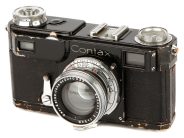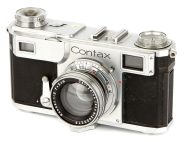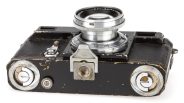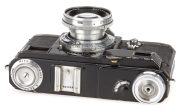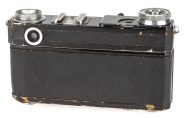Contax II
35mm MF film rangefinder camera • Discontinued
- Announced:
- · 1936
- Production status:
- ● Discontinued
- Country of design:
- · German Reich
- System:
- · Contax (1932)
Specification
| Format: | |
| 35mm full frame | |
Film type: | 135 cartridge-loaded film |
| Contax [34.85mm] | |
| Shutter: | |
Type: | Focal-plane |
Model: | Mechanical |
Speeds: | 1/2 - 1/1250 + B, T |
| Exposure: | |
Exposure metering: | None |
Exposure modes: | Manual |
| Rangefinder and Viewfinder: | |
Rangefinder: | Built-in, combined with viewfinder |
Viewfinder: | Built-in, combined with rangefinder |
Finder magnification: | 0.75x |
Actual rangefinder base: | 90mm |
Effective rangefinder base: | 67.5mm |
Bright-line frames: | - |
Parallax compensation: | - |
| Physical characteristics: | |
Weight: | <No data> |
Dimensions: | <No data> |
Manufacturer description
The Contax is famous as the most versatile of all precision miniatures. The distance meter and view-finder are combined in one eye-piece, a method which ensures unequalled speed, convenience and accuracy both in composing the picture and in focussing. Fifteen interchangeable Zeiss lenses, apertures from f/1.5. focal lengths from 1 1/8" to 20", are available, thus enabling the Contax to tackle all branches of photography. The metal focal plane shutter speeded to 1/1250th second is unaffected by climatic conditions, and is fitted with delayed action release. Speeds are visible on one knob, and can be adjusted both before and after winding the shutter, which action also advances the film for the next exposure. The shutter release is conveniently placed in the centre of the film winding knob, and the elegant shape of the die-cast body enables it to be held steadily in the hand while making exposures. The back of the Contax is detachable for cleaning, and permits a plate back to be used. The wide range of accessories available makes the Contax adaptable for photo-micrography, clinical photography, and other specialized branches. The Contax takes 24 x 36 mm. negatives, in which size a wide selection of sensitive material is available in lengths for 12 or 36 exposures.
From the British Journal Photographic Almanac (1937)
A new and much improved model of this camera is now available under the name of Contax II, which incorporates several features worthy of note. The shape and finish are the first things which strike the observer as having undergone change. The ends have been bevelled off so as to present a rounded appearance which is both better in looks as well as more comfortable to hold in the hands when in use. The finish, which was formerly of black enamel, is now partly dull and partly bright chromium; the top and bottom plates, lens-panel and mount, as well as the various fittings, such as winding and rewinding-knobs, and finder-frames, are plated in this manner. More important than finish, however, are radical constructional improvements which make for greater ease in manipulation. In the first place, the combined shutter-winding and film transport-knob has been transferred to the top of the camera, so that by virtue of its ready-accessibility exposures in fairly rapid succession are easier than formerly. The release-button is now in the middle of this winding-knob, and the exposure counting-dial has been built in.
The highest shutter-speed has been increased to 1/1,250th sec., and the whole range of shutter-settings down to 1/2 sec. is now visible at once. Speeds may be set, as previously, either before or after winding. A built-in delayed-action mechanism facilitates self-portraiture and enables the operator to appear in a group, whilst by suitable manipulation this mechanism can be used to extend the range of automatic exposures to 1 sec.
The other outstanding improvement is the combination of the viewfinder and distance meter in such a way that the one eyepiece serves for both, so that the entire field of view can be seen simultaneously with the rangefinder image. The mount of the Sonnar 5 cm. f/2 lens has been so redesigned that it is now collapsible into the body of the camera, making it of much smaller bulk.
As might be expected, these improvements necessitate indking the Contax II somewhat more expensive than its predecessor, so that the prices now range from £40 10s. 0d. to £65 15s. 0d., according to the optical equipment provided.
From the Back Focus magazine (No. 54, August 2004)
At the end of World War Il the Zeiss Ikon factory in Dresden could no longer produce the Contax or other cameras, due to the heavy Allied bombing in February 1945.
Complete reconstruction of the production line was needed; even prototype models and working drawings kept in the basement had been destroyed.
Contax production had slowed to a crawl early in 1943 due to a lack of material and the need to produce war equipment. The Army and Navy used the few cameras made at this time.
Due to the Yalta agreement of February 1945, the Carl Zeiss Jena optical works and the Zeiss Ikon camera plant in Dresden would be in the Soviet Occupation Zone. The 80th Infantry Division of the US Third Army arrived two months before the Russians Army on April 1945. The Americans withdrew to what became West Germany in June, taking with them a select group of scientists, managers and their immediate families, as well as large amount of documents and a small amount of hardware, essential to a new Zeiss operation in Stuttgart.
Later in 1945 the Soviet Union decided that the production of Contax cameras would be moved to an USSR factory, and would be called the Volga, a name that was never used. The Russians demanded eight complete sets of blueprints and technical drawings and a set number of complete samples of the camera, and each of the lenses and accessories. As there was no Contax camera production line in operation, this had to be rebuilt in East Germany to ensure the quality of their new camera. The Russians instructed Carl Zeiss Jena to build three complete sets of manufacturing tools and assembly materials for the Contax. One of these sets was taken to a Carl Zeiss subsidiary called Saalfelder Apparatebau Gesellschaft (SAG), which had been established during the war. It is an interesting aside that a few years later the Werra cameras from VEB Carl Zeiss Jena were produced in the same factory.
In February 1946, the Saalfeld works were instructed to produce the rare Contax Jena camera at an accelerated rate. Production ended in March 1947 and the total numbers required were 3,800 units, however the actual production could have been much lower, possibly only 1200. At the present time only 133 Jena cameras are known to exist, and out of that number only four Contax III's with the built-in exposure meter. Seven cameras are factory painted beige colour on the metal parts with brown leather, four bodies have a black frontal area with logo and one without the logo, and another is finished in all black enamel. Both of these black or partial black cameras have the top of the winder and the rewind knob also in black enamel. All but one of these cameras have normal aluminium lens barrels, however one black camera has a black enamel lens barrel. Other very rare variations are that the normal black bezel around the delayed action lever are chrome, and a small number of cameras have a flash socket on the top deck next to the accessory shoe. Even the film rewind knob had variations with three groves, three and a half grooves and four grooves. Most, but not all, Contax Jena cameras have a brass back plate instead of the normal aluminium plate.
The last batch of the Jena Contax cameras ran from serial number 30500 to Jena camera 30600 and these cameras have been dated from 1951 - 1956. Only 100 cameras made within five years? It is thought that these cameras were assembled from parts that were lying around and could be used to build fully functioning cameras.
In 1947 during the ending of the Jena Contax era, the first Kiev cameras were being produced at Saalfeld. A small number of these camera bodies, both Jena Contax and Jena Kiev carried the Carl Zeiss Jena imprint in the accessory shoe with a second serial number. Two Jena Contax bodies have numbers 6066/470006 and 6070/470010 and the Jena Kiev cameras have 5905/470030 and 5908/470033. Strangely, a small number of Jena Kiev bodies have serial numbers in the 30500 batch. All other Kiev cameras are easy to date as the first two digits of the serial number denote the year of production.
At the end of production of the Jena Contax, 98% of all production equipment from Jena and Saalfeld was taken to the Soviet Union. In early 1947 many Carl Zeiss and Zeiss Ikon scientific personal and managers were taken to the Zavod Arsenal factory in Kiev for the start of production of the Kiev cameras.
LIST OF VARIATIONS:
DRESDEN CONTAX JENA CONTAX
CAMERA FRONT PLATE: Engraved / Stamped.
SERIAL NUMBER: Interior on back door, bottom of interior chassis, accessory shoe or rewind knob / Accessory shoe and bottom of interior chassis.
BACK DOOR: Aluminium / Brass.
ACCESSORY SHOE: Rounded corners / Square corners.
SELF TIMER COVER PLATE: Chrome / Black enamel.
REWIND KNOB SCREW: Large / Small.
REWIND RELEASE BUTTON: Smooth with circular grooves / Serated edge with center screw.
SHUTTER SPEED NUMBERS: Small & large engravings / Small engravings.
STAND ON BACK DOOR: Cutaway / Solid.
FILM PRESSURE PLATE: Black / Grey.
REAR DOOR: Zeiss Ikon logo in leather / No logo.
REWIND KNOB: Four milled rings / Three milled rings.
REWIND KNOB HOLDING SCREW: Small / Large.
FILM GUIDES: Square at ends / Tapered at ends.
OCCULAR FOR VIEWFINDER: Concentric rings / No rings.
RANGE FINDER COLOURS: Gold & yellow images / Light & darker grey images.
TRIPOD SURROUND: Eught concentric grooves / Twelve concentric grooves.
Contax II special editions (1)
- Contax II Ivory - 1947
Similar cameras (8)
| Model | Shutter | Metering | Modes | Year |
|---|---|---|---|---|
| Kiev-4 akaКиев-4 |
M, 1/1250 | Window | M | 1957 ● |
| Kiev-4A akaКиев-4А |
M, 1/1250 | -- | M | 1958 ● |
| Kiev-4AM akaКиев-4АМ |
M, 1/1000 | -- | M | 1980 ● |
| Kiev-4M akaКиев-4М |
M, 1/1000 | Window | M | 1976 ● |
| Kiev-5 akaКиев-5 |
M, 1/1000 | Window | M | 1968 ● |
| Kiev-III[A] akaКиев-III[А] |
M, 1/1250 | Window | M | 1952 ● |
| Kiev-II[A] akaКиев-II[А] |
M, 1/1250 | -- | M | 1947 ● |
| VTSVS akaВТСВС |
M, 1/500 | -- | M | 1949 ● |

